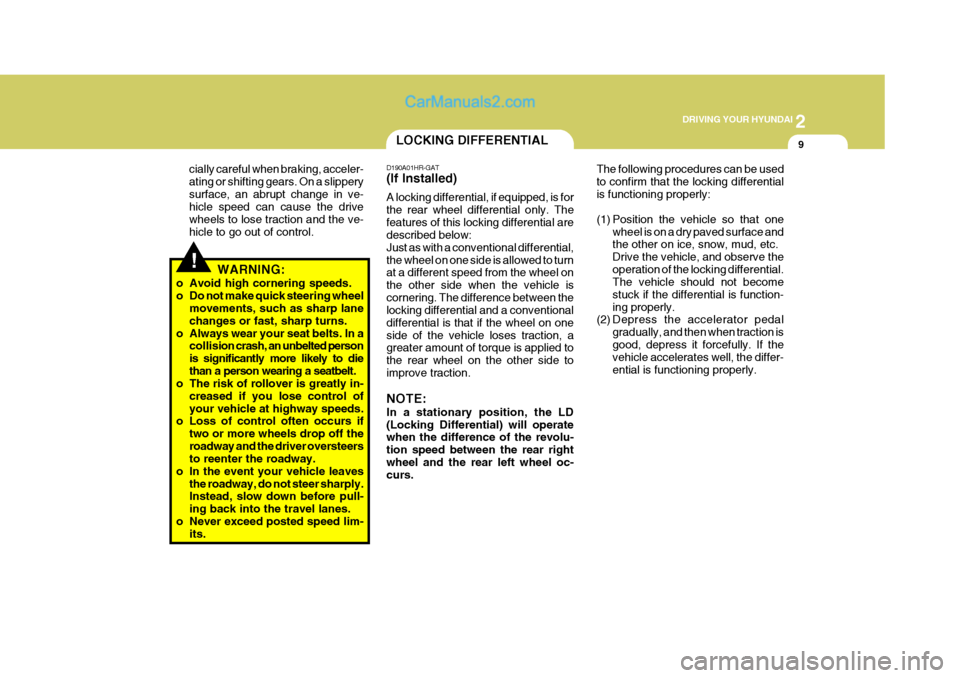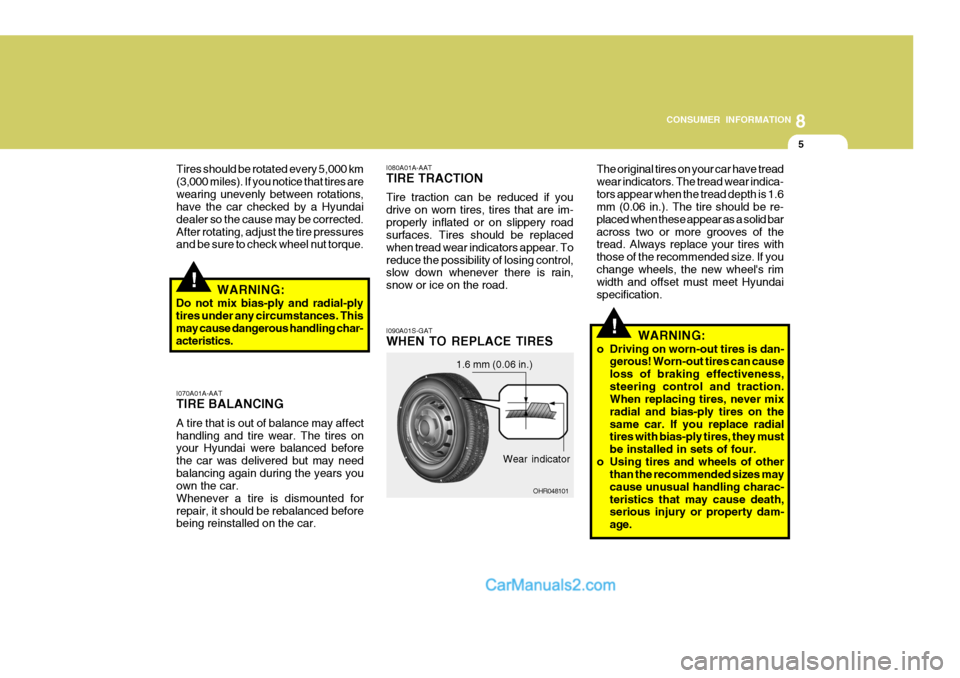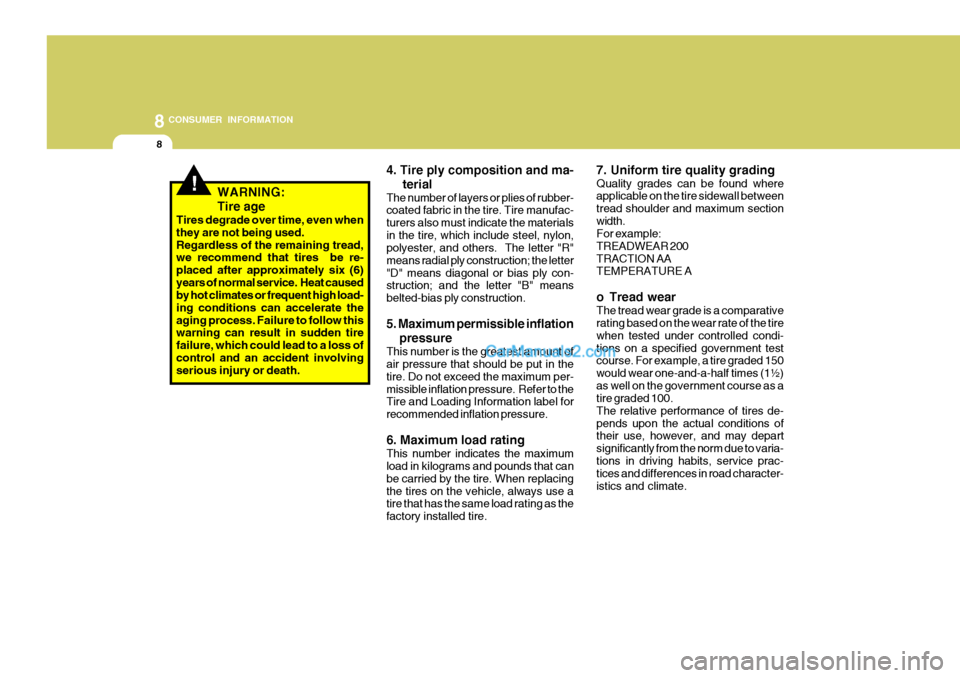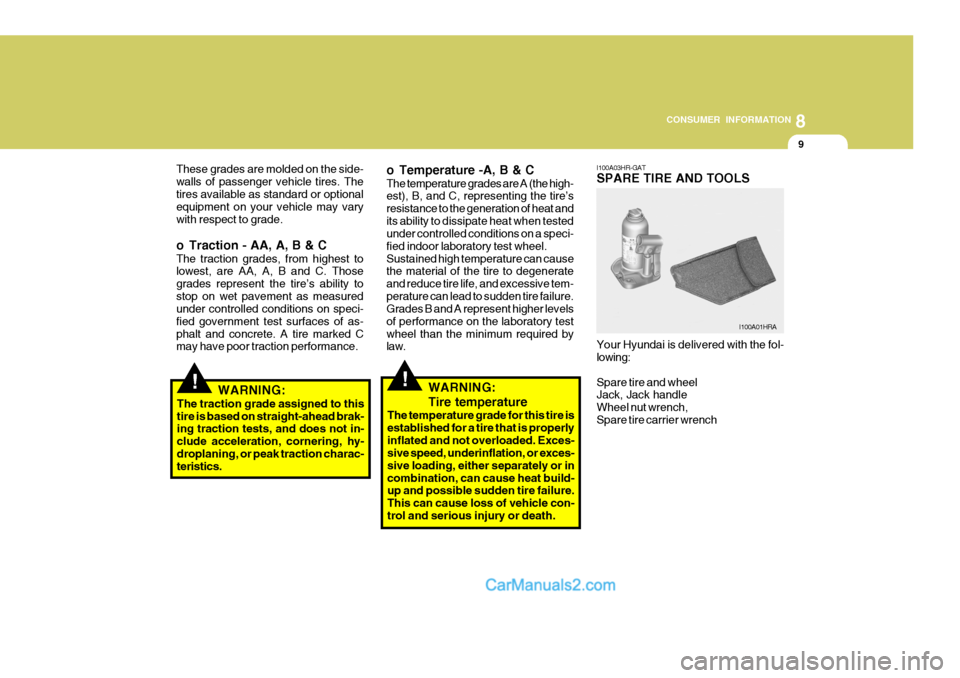2012 Hyundai H-100 Truck traction control
[x] Cancel search: traction controlPage 105 of 217

2
DRIVING YOUR HYUNDAI
9LOCKING DIFFERENTIAL
!
cially careful when braking, acceler- ating or shifting gears. On a slipperysurface, an abrupt change in ve- hicle speed can cause the drive wheels to lose traction and the ve-hicle to go out of control.
WARNING:
o Avoid high cornering speeds.
o Do not make quick steering wheel movements, such as sharp lane changes or fast, sharp turns.
o Always wear your seat belts. In a collis ion crash, an unbelted person
is significantly more likely to die than a person wearing a seatbelt.
o The risk of rollover is greatly in-
creased if you lose control ofyour vehicle at highway speeds.
o Loss of control often occurs if
two or more wheels drop off theroadway and the driver oversteers to reenter the roadway.
o In the event your vehicle leaves the roadway, do not steer sharply.Instead, slow down before pull- ing back into the travel lanes.
o Never exceed posted speed lim- its. D190A01HR-GAT (If Installed) A locking differential, if equipped, is for the rear wheel differential only. Thefeatures of this locking differential are described below: Just as with a conventional differential,the wheel on one side is allowed to turn at a different speed from the wheel on the other side when the vehicle iscornering. The difference between the locking differential and a conventional differential is that if the wheel on oneside of the vehicle loses traction, a greater amount of torque is applied to the rear wheel on the other side toimprove traction. NOTE: In a stationary position, the LD (Locking Differential) will operate when the difference of the revolu- tion speed between the rear rightwheel and the rear left wheel oc- curs.
The following procedures can be used to confirm that the locking differentialis functioning properly:
(1) Position the vehicle so that one
wheel is on a dry paved surface and the other on ice, snow, mud, etc. Drive the vehicle, and observe theoperation of the locking differential. The vehicle should not become stuck if the differential is function-ing properly.
(2) Depress the accelerator pedal
gradually, and then when traction isgood, depress it forcefully. If the vehicle accelerates well, the differ- ential is functioning properly.
Page 202 of 217

8
CONSUMER INFORMATION
5
!
!
I070A01A-AAT TIRE BALANCING A tire that is out of balance may affect handling and tire wear. The tires on your Hyundai were balanced before the car was delivered but may needbalancing again during the years you own the car. Whenever a tire is dismounted forrepair, it should be rebalanced before
being reinstalled on the car. I080A01A-AAT TIRE TRACTION Tire traction can be reduced if you drive on worn tires, tires that are im-properly inflated or on slippery road surfaces. Tires should be replaced when tread wear indicators appear. Toreduce the possibility of losing control, slow down whenever there is rain, snow or ice on the road. I090A01S-GAT WHEN TO REPLACE TIRES
Tires should be rotated every 5,000 km (3,000 miles). If you notice that tires arewearing unevenly between rotations, have the car checked by a Hyundai dealer so the cause may be corrected.After rotating, adjust the tire pressures and be sure to check wheel nut torque.
WARNING:
Do not mix bias-ply and radial-ply tires under any circumstances. Thismay cause dangerous handling char- acteristics.
Wear indicator
1.6 mm (0.06 in.)
OHR048101 WARNING:
o Driving on worn-out tires is dan- gerous! Worn-out tires can cause loss of braking effectiveness,steering control and traction.
When replacing tires, never mix radial and bias-ply tires on thesame car. If you replace radial tires with bias-ply tires, they must be installed in sets of four.
o Using tires and wheels of other than the recommended sizes maycause unusual handling charac-teristics that may cause death, serious injury or property dam- age.
The original tires on your car have treadwear indicators. The tread wear indica-tors appear when the tread depth is 1.6 mm (0.06 in.). The tire should be re- placed when these appear as a solid baracross two or more grooves of the tread. Always replace your tires with those of the recommended size. If youchange wheels, the new wheel's rim width and offset must meet Hyundai specification.
Page 205 of 217

8CONSUMER INFORMATION
8
7. Uniform tire quality grading Quality grades can be found where applicable on the tire sidewall between tread shoulder and maximum sectionwidth. For example: TREADWEAR 200TRACTION AA TEMPERATURE A
o Tread wear The tread wear grade is a comparative rating based on the wear rate of the tire when tested under controlled condi-tions on a specified government test course. For example, a tire graded 150 would wear one-and-a-half times (1½)as well on the government course as a tire graded 100. The relative performance of tires de-pends upon the actual conditions of their use, however, and may depart significantly from the norm due to varia-tions in driving habits, service prac- tices and differences in road character- istics and climate.
!WARNING: Tire age
Tires degrade over time, even when they are not being used.Regardless of the remaining tread, we recommend that tires be re- placed after approximately six (6)years of normal service. Heat caused by hot climates or frequent high load- ing conditions can accelerate theaging process. Failure to follow this warning can result in sudden tire failure, which could lead to a loss ofcontrol and an accident involving serious injury or death. 4. Tire ply composition and ma-
terial
The number of layers or plies of rubber-coated fabric in the tire. Tire manufac- turers also must indicate the materialsin the tire, which include steel, nylon, polyester, and others. The letter "R" means radial ply construction; the letter"D" means diagonal or bias ply con- struction; and the letter "B" means belted-bias ply construction. 5. Maximum permissible inflation
pressure
This number is the greatest amount of air pressure that should be put in the tire. Do not exceed the maximum per-missible inflation pressure. Refer to the Tire and Loading Information label for recommended inflation pressure. 6. Maximum load rating This number indicates the maximum load in kilograms and pounds that can be carried by the tire. When replacingthe tires on the vehicle, always use a tire that has the same load rating as the factory installed tire.
Page 206 of 217

8
CONSUMER INFORMATION
9
I100A03HR-GAT SPARE TIRE AND TOOLS Your Hyundai is delivered with the fol- lowing: Spare tire and wheel Jack, Jack handle Wheel nut wrench,Spare tire carrier wrench
I100A01HRA
These grades are molded on the side- walls of passenger vehicle tires. Thetires available as standard or optional equipment on your vehicle may vary with respect to grade.
o Traction - AA, A, B & C The traction grades, from highest to lowest, are AA, A, B and C. Those grades represent the tire’s ability tostop on wet pavement as measured under controlled conditions on speci- fied government test surfaces of as-phalt and concrete. A tire marked C may have poor traction performance. o Temperature -A, B & C The temperature grades are A (the high- est), B, and C, representing the tire’s resistance to the generation of heat andits ability to dissipate heat when tested under controlled conditions on a speci- fied indoor laboratory test wheel.Sustained high temperature can cause the material of the tire to degenerate and reduce tire life, and excessive tem-perature can lead to sudden tire failure. Grades B and A represent higher levels of performance on the laboratory testwheel than the minimum required by law.
!WARNING:
The traction grade assigned to this tire is based on straight-ahead brak- ing traction tests, and does not in- clude acceleration, cornering, hy-droplaning, or peak traction charac- teristics.!WARNING: Tire temperature
The temperature grade for this tire is established for a tire that is properlyinflated and not overloaded. Exces- sive speed, underinflation, or exces- sive loading, either separately or incombination, can cause heat build- up and possible sudden tire failure. This can cause loss of vehicle con-trol and serious injury or death.